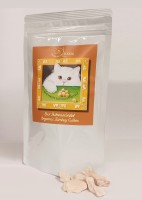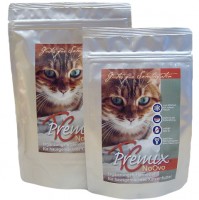
Please check back. Thank you!
Prices incl. VAT plus shipping
Delivery time 6 business days
- Order number: 0389021
-
- mix with raw meat
- easy to prepare
- freeze finished portions
- mimics cats´ natural diet of mice
The TCPremixNoOvo Raw Diet Premix formula is a source of essential, natural, and bioavailable nutrients to complete fresh, raw meat as a cat food. The homemade cat food made with TCPremixNoOvo and by following the preparation instructions mimics the nutritional composition of a mouse and is recommended to be fed as a staple diet for healthy cats of all ages.
Egg yolk has been omitted from this formula, making it suitable for cats with a sensitivity to egg or poultry. Alternatively, this premix gives you the option of adding fresh egg yolk to the cat food during preparation.
Ingredients
Whole Bone Extract, Gelatin, Whey Protein, Calcium Carbonat, Seaweed Powder.
Additives per 1 kg: Taurine, Vitamin-B-Complex (Vitamin B1, Vitamin B2, Niacinamide, Pantotenic acid,
Vitamin B6, Vitamin B12, Biotin, Folic acid, Choline), Vitamin E, Vitamin D3 (2777 IU).
Typical Analysis
Protein ...........59,5%
Fat...................<1,0%
Fibre ...............<0,3%
Ash..................33,5%
Moisture.......... 6,1%
Manufactured in Germany by Tatzenladen
Recipe for 1 kg meat with liver:
1. Measure 40 g TCPremix into a bowl.
2. Add 190 ml water and combine thoroughly.
3. Add 900 g raw meat of your choice and 100 g raw liver. Combine.
4. Divide into daily servings and freeze in suitable containers.
5. Thaw before feeding.
Prepares 1230 g finished food
TCPremix storage
Whether or not a product keeps fresh right up to the use-by date also depends on how it is stored. The premix will remain fresh and of good quality right up to the best before date if it is stored in the freezer between uses (e.g. think of condensation water in a fridge). Freezing is a way of preserving food for extended periods and nearly unchanged in nutritional quality, because it prevents the growth of microorganisms.
Since the premix is a powdered supplement, you can easily measure the amount you need for a batch or a day and put the rest of the powder back into the freezer. If you feel uncomfortable with freezing and wish to store the premix differently (cupboard etc.), we recommend re-sealing the pouch properly after each use, by squeezing out as much air as possible and keep it in a dry and cool place. But, however, it is most essential to keep the premix away from any moisture.
Serving sizes for adult cats
Any recommendations on serving sizes we can make can only be a good guess - a starting point to use in your play with your cat’s portion sizes and mealtime frequency. Determining your cat’s ideal daily portion size is unfortunately not as easy as a chart which tells you: if your cat weighs this much, feed her that amount. Cats are individuals. Some are big, but thin. Others are small, but fat. They are young and old, male and female, active or sedate, and more. Some have fast metabolism and others don’t. Any chance of providing you with a simple chart is made more difficult by the fact, that a homemade diet will turn out differently with the meat you use and with how precisely you follow instructions. Some customers use lean poultry, other use fatty beef. A fatty beef diet will be more filling and calorie dense than the same volume of a lean turkey diet. Some customers add more water, giving the food more volume but not more calories, while others omit water and wonder why their cats gain weight on so little food.
Caregivers are often distressed about their cat’s behavior of finishing their plate in less than a minute, asking for more food, pestering them at the fridge, or taking food stuff off counters or out of the trash, prompting them to think that their cat is starving or lacking something! Some cats don’t do this, but most will not miss an opportunity to eat. It is natural for an animal to be opportunistic, and this is part of their instinct to survive. However, much of this is conditioning: how your cat was raised and how your cat has trained you!
Food requirement should be based entirely on body condition, and not on behavior. If your cat suddenly looses weight without changes in the diet, consult with your Veterinarian about possible illness or internal parasites.
It is especially difficult to monitor food intake and its effects on a cat allowed outdoors. Outdoors, your cat can regurgitate food without you knowing, and all you notice is that he or she is loosing weight. The eating of mice and other prey will add calories, but also predispose your cat to intestinal parasites. Outdoor, cats will often travel long distances, which takes extra calories. Outdoor, cats may scavenge food from neighbors, which puts them at a great risk not only from weight gain.
Our suggestions are to feed a daily portion of 130 g – 175 g as two or three meals every day
Unless you have a very large cat, like a young, active, outdoor, male Main Coon cat, or a crazy Siamese, 99% of cats will fall into this portion range. Some older, more sedate cats will actually gain weight on that amount of food a day.
Cats are individuals. Some will maintain a level of excitement about food throughout their live. Others are largely uninterested in eating, and need coaxing to eat even as kittens. Most cats do well eating three meals every day, but some are not interested in eating more often than twice every day; sometimes they only show enthusiasm for one meal per day. Other cats will eat anything, any time, for no reason. Cats’ personality and emotional state is very much expressed by how they eat!
Cats of the genus Felis, including the domestic cat, are adapted to prey on rodents, small birds, and the occasional reptile and amphibian as the main staple of their natural diet. A single mouse weighs no more than 30 gram, providing approximately 60 kcal. In order to meet their daily caloric requirement, cats must eat an average of five prey animals every day. This amount of food is not consumed all as one meal, but as separate meals throughout the day as the cats succeed in catching that prey. Field observations have concluded that most small cat species are adapted to and prefer to be active during dusk and dawn - the time when they will hunt most of their prey - resulting in an intake of several smaller “meals” during these hours. Naturally, cats will rest, groom, doze, or sleep during daytime hours.
While we can draw some practical insight from the natural model, feeding five meals of 30 gram each to our cats during the morning and evening hours is hardy a possible solution for most of us. Our personal experience has been that cats do very well eating two meals every day of 50 g – 70 g each.
Weighing your cat's serving is a good tool, because we have a natural tendency to over-feed
Regurgitation of food can be almost entirely abolished by feeding meal sizes not exceeding 35 g, and to feed the daily requirement as 3-4 meals. Young, large, active cats who require more than 140 g of food every day should be given an extra meal rather than increasing the size of their meal.
The stomach of a cat is about the size of a walnut when empty. It can stretch, but trying to fit a 115 g of food into it as one meal, is “over-stretching” it a bit. Saliva and digestive juices will add additional volume. A cat will not always select instinctively what he or she needs and how much.
One lesson, which keeps repeating itself to us, is: cats are individuals. While we can give you guidelines, none of our suggestions will work for everyone. Cats are a joy and a challenge all in one. They are a challenge especially when feeding them. So specialized in what they would naturally eat, caregivers have a very narrow margin of error of what cats thrive on or die from. One thing is certain, though: if you invite a carnivore into your life that eats meat, it is not going to be cheap! Unfortunately, you don’t get the deal of good AND cheap when feeding cats.
With TCPremix you have the choice and control over the primary ingredient in your cat’s food: the meat.
During our studies and research we have tried nearly all possible sources of meat for our cats’ food, and the following list demonstrates how creative you can get, depending on your resources and preferences. Muscle and organ meats are the most essential foods for your cat, and special care should be applied when selecting them.
Meats must be raw, fresh and human-grade. Feed a variety of meats to your cat. This provides stimulation. Prevents fixation and guarantees a well balanced meal plan with little room for deficiencies.
• Chicken & Turkey - breast, fillet or thigh, heart
• Rabbit - stewing meat, boneless loins, neck, shoulder
• Venison - stewing meat, neck, shank, shoulder
• Lamb - boneless stewing meat, shank, leg or butt
• Beef - stewing meat, heart, boneless steak or roast
To make cat food, grind meats or cut into small chunks.
Please feel encouraged to try more meat varieties.
When using TCPremix, if possible, choose liver from the same type of animal as the meat used in preparing your cat’s food. However, if you cannot match up meat and liver, please don’t omit the liver altogether. Liver is an essential part of your cat’s diet. Instead, prepare your cat’s food with miss-matched meat and liver.
Can I use meat with bone with TCPremix?
Please do not use bones or meat with bone (like whole ground chicken, thighs with bone, backs, and or wings; or whole ground rabbit) when preparing cat food with the TCPremix premix. All our formulas already contain all the essential minerals, which would otherwise be supplied to the cat from her prey’s bones. Preparing our raw diet premix with meat that contains bone can cause constipation and unbalance the finished cat food.
....coming soon. Please check back.
Tatzenladen
Inh. Nicole Kipp-Meilwes
Bärenshöfter Straße 16, 24980 Schafflund, Deutschland
E-mail: info(at)tatzenladen.de









































